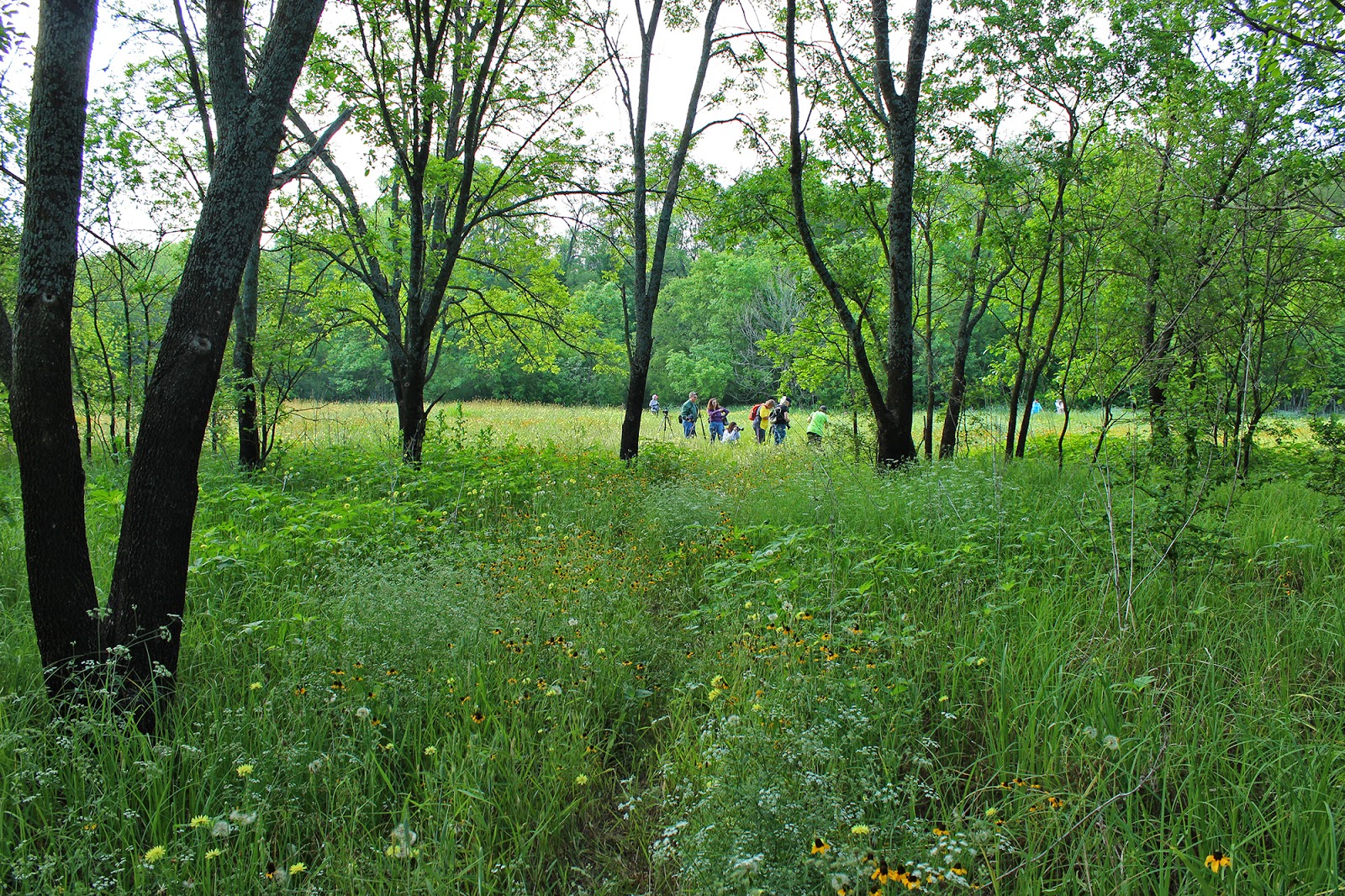Liz Fernandez, Director of Trinity Watershed Management, photographs a portion of the burned fifteen acres of the Great Trinity Forest in the Big Spring Conservation Area, July 25, 2014. Currently under investigation as an act of arson. Stark contrast to the area as it looked less than two months before during the height of the wildflower bloom.
It was a week many had looked forward to for years. A day when the City of Dallas would formally adopt a formal management plan for one of the Great Trinity Forest's real gems, Big Spring. A week when that same rough draft management plan, the first for the Great Trinity Forest and one of the only urban forest management plans in Texas would be put to use for the first time. Then the fire happened.
A Brief Summary Of The Fire
Word of the fire spread quickly. First noticed by a Dallas Police Department helicopter in the early afternoon of July 23, 2014. The police on the scene relayed that Air One the police helicopter observed four different burning areas. Dallas Fire Rescue was summoned to the scene and fought the fire till sunset.
| Image may be NSFW. Clik here to view.  |
| Station 51 Brush Fire Truck stuck in Bryan's Slough. The truck was headed back to the burning wildfire just beyond the Slough. Photo courtesy Zada Pemberton |
If it was arson, we all hope that the party responsible is brought to justice and prosecuted to the limit of the law. It is quite unsettling to all involved that something like this occurred. Not just the fire itself but that firefighters risked their own lives fighting the fire.
| Image may be NSFW. Clik here to view.  |
| Dallas Fire Rescue Firefighters on the evening of July 23, 2014 in the clasping coneflower field at Big Spring. Photo courtesy Zada Pemberton |
| Image may be NSFW. Clik here to view.  |
| Map of July 23, 2014 wildfire in the Great Trinity Forest. 15 acres. |
At right is a map of the extent of the fire damage. It was contained on the north and south by Bryan's Slough. On the north end the fire stopped at the edge of a large swamp area which extends all the way to Bruton Road.
| Image may be NSFW. Clik here to view.  |
| Charred goat head in the wildfire burned section of the Texas Horse Park |
| Image may be NSFW. Clik here to view. 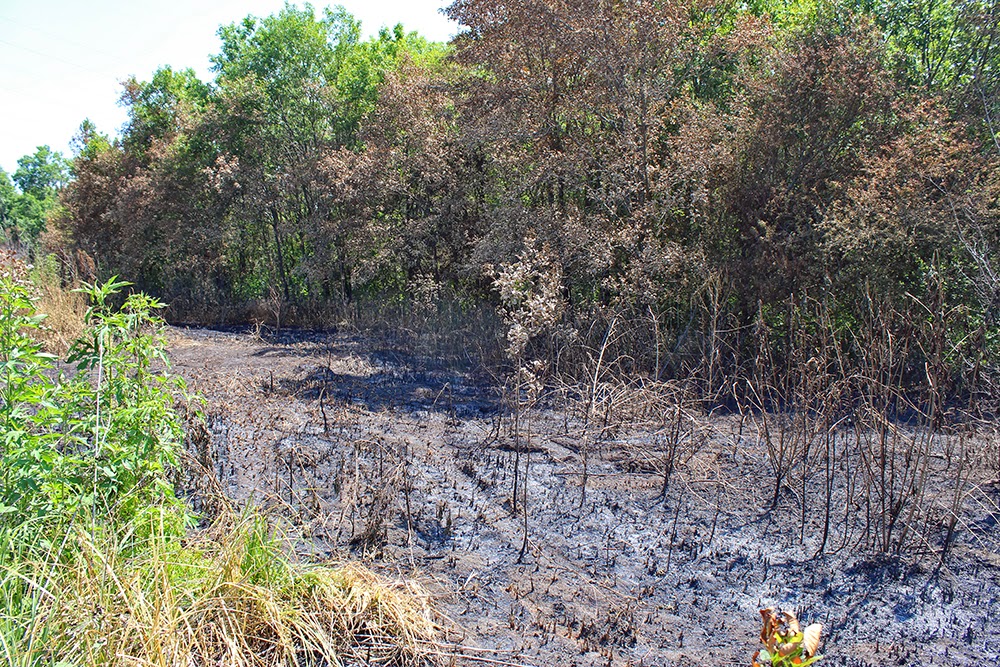 |
| Southern limit of the fire on west side of Texas Horse Park Dallas, Texas |
The fire was stopped at where Bryan's Slough crosses from east to west under the powerline ROW. Dallas Fire Rescue worked this area too, a number of small caliper trees mostly species of ash and cedar elm appear to have been either burned or scorched in this area.
| Image may be NSFW. Clik here to view.  |
| Northern extent of the fire, a firefighter walks the Hill property looking for hotspots. July 25, 2014 |
The Fire Scene At Big Spring
The disparity of the fire scenes when viewed through photos in before/after makes one cringe. Taken less than sixty days apart the first photo shows members of a Meetup nature photography group at Big Spring. The lower photo taken in almost the same spot shows two firefighters from Station 34 working on the hotspots in the treeline west of the coneflower field.
| Image may be NSFW. Clik here to view.  |
| Firefighters from Dallas Fire Rescue Station 34 work on putting out one of the hotspots in the Great Trinity Forest July 25, 2014 |
By 10am, the wind started kicking up from the south some and inside the treeline the slow smoldering embers in the larger downed trees puffed to life.
| Image may be NSFW. Clik here to view.  |
| Master Naturalist Jim Flood partially obscured by smoke stands at the base of a still smoldering Ash tree, some 48 hours after the start of the wildfire |
| Image may be NSFW. Clik here to view.  |
| A Dallas Firefighter leads the way through still smoking hot spots behind him is Texas Parks and Wildlife Biologist Brett Johnson who is trained in wildfire management and fires |
| Image may be NSFW. Clik here to view. 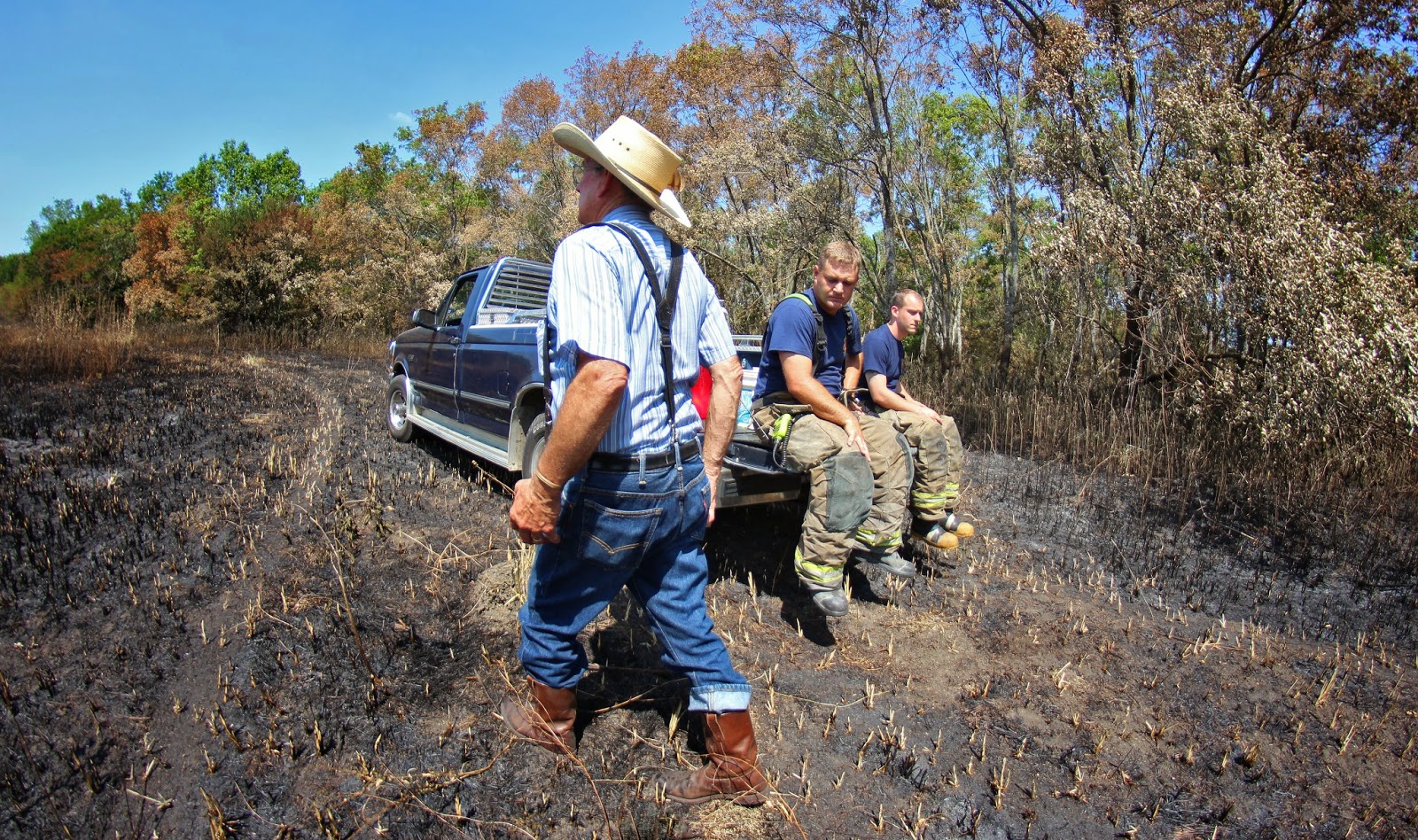 |
| Billy Ray Pemberton with two firefighters, a pile of buckets, shovels and rakes in his pickup, Big Spring, July 25, 2014 |
| Image may be NSFW. Clik here to view.  |
| Applying a truckload of water in the distance to some of the burned areas on Friday July 25, 2014 |
| Image may be NSFW. Clik here to view.  |
| Burned stalks of wildflowers and sedge grass in the wildflower field, Big Spring, Friday July 25, 2014 |
What is lost is the groundbreaking work to some extent that was going on in this field by Jim Flood and Tim Dalbey. Earlier in the week it was discussed not to mow this area so that late summer and fall blooming species of plants could be identified. This area had been yielding many plants that had not been documented in Dallas County for decades or were absent from records altogether. It is a great sense of loss that the work going on here will be curtailed till another growing season.
Unknown is the extent of the damage. Poking around under the soil surface it appears that there is good moisture just under the surface and hopefully root systems and dormant seeds were not affected.
| Image may be NSFW. Clik here to view. 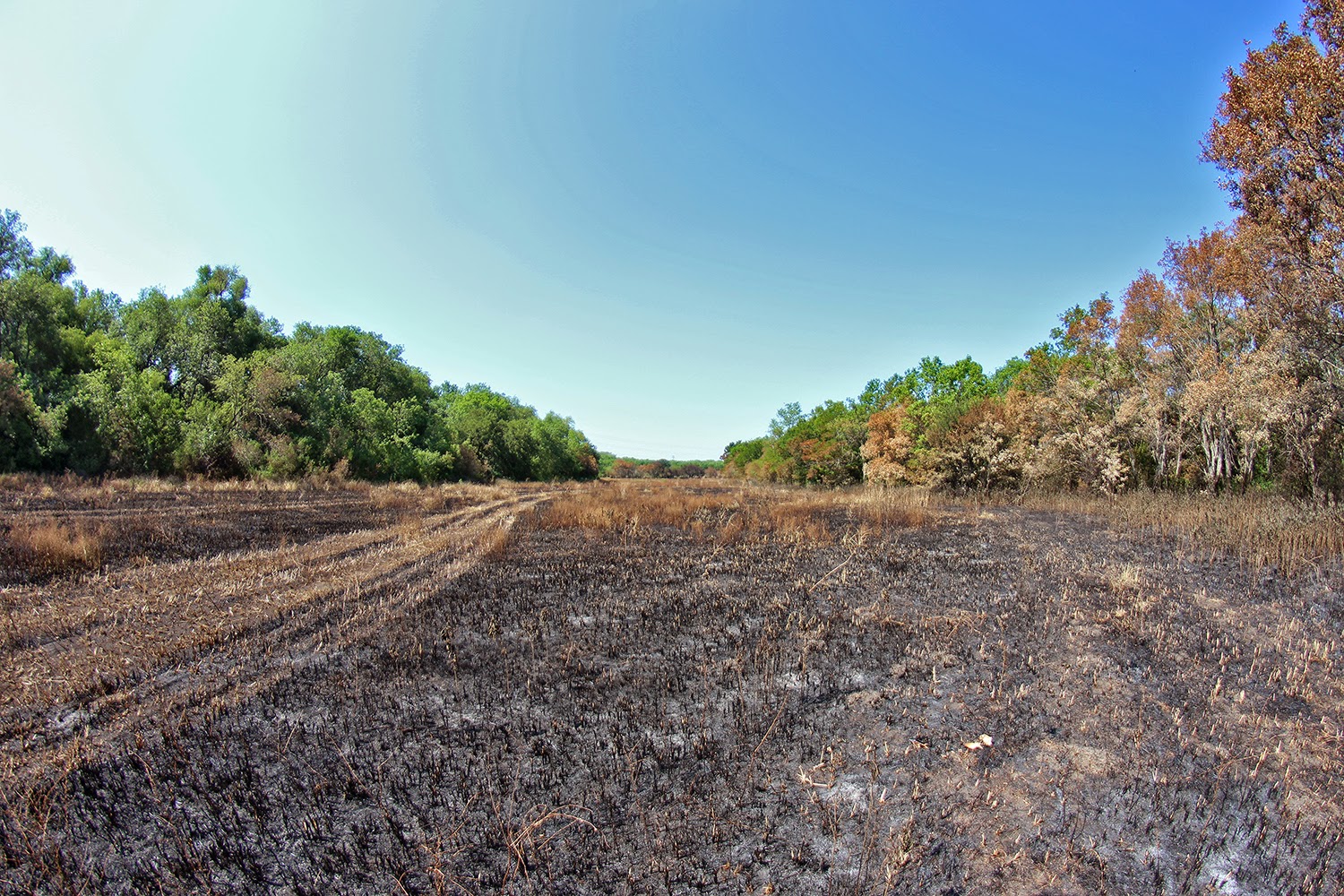 |
| Big Spring's clasping coneflower field as it looked July 25, 2014 |
| Image may be NSFW. Clik here to view. 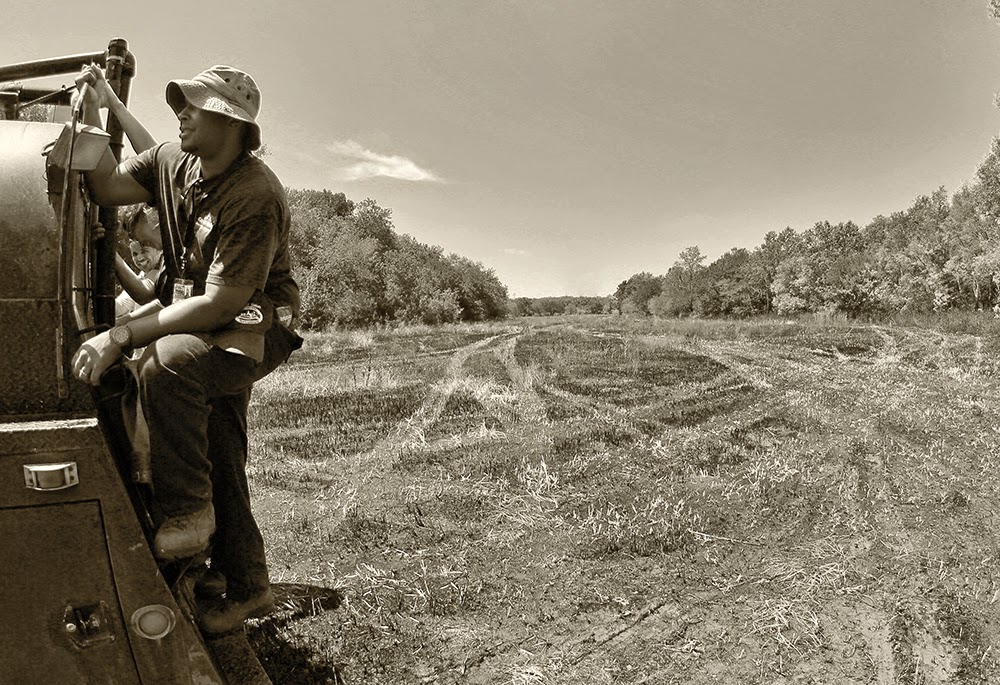 |
| Paul White, City of Dallas Trinity Watershed Management riding the back of a water truck at Big Spring July 25, 2014 |
| Image may be NSFW. Clik here to view. 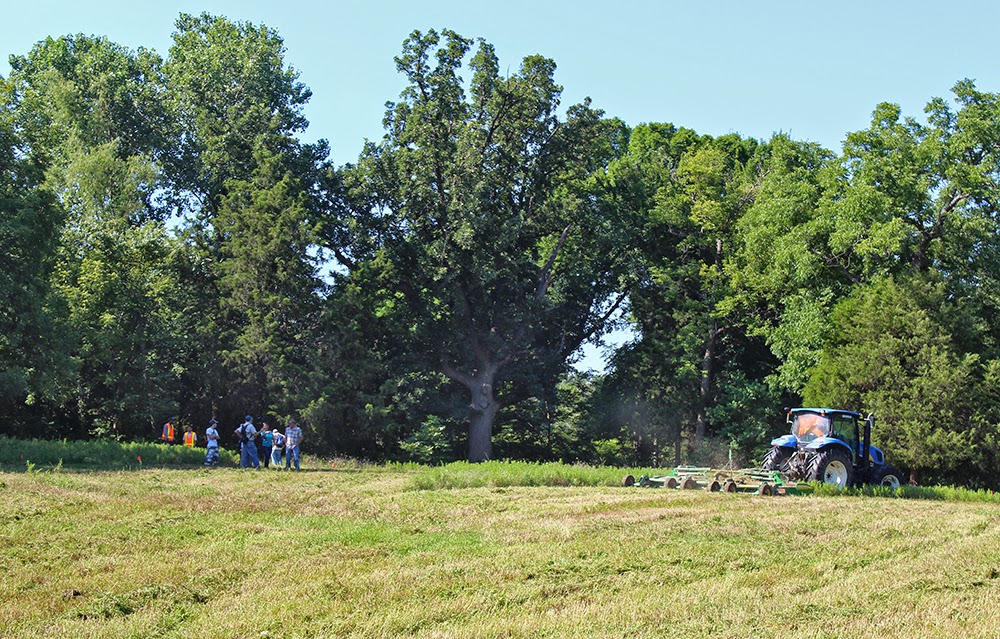 |
| Big Spring's mighty Bur Oak towers high above the first run of a managed mowing plan at Big Spring. Looking south. |
One man, Billy Ray Pemberton, has mowed this land for many years on his own dime and using his own equipment. For the last ten years it has been a near solo effort by him. The overall management plan should build upon his decades of work here and be used as a touchstone for the future.
In the winter 2013-2014 the Lewisville Aquatic Ecosystem Research Facility was contracted by the City of Dallas to develop a plan with citizen input for the aquatic and outfall aspects of Big Spring. This past week in late July, we learned that LAERF would also work on a mowing plan for Big Spring which surprised a few of us. Citizen input continues into August on that front.
| Image may be NSFW. Clik here to view.  |
| A native hibiscus blooms on the edge of the mowing area at Big Spring. In the background is the historic Bur Oak and the spring itself |
| Image may be NSFW. Clik here to view.  |
| Mowing at Big Spring is hoped to create buffer zones along the outfall of the spring water and help smaller tree seedlings repopulate the area back into a native bottomland |
Image may be NSFW.
Clik here to view.
 The management ideas for Big Spring will be adaptive and flexible inside the framework of what will hopefully become an official Dallas Landmark. The process began a year ago and is working through City Hall. Getting from here to that goal requires lots of planning and restructuring of how forested lands are managed.
The management ideas for Big Spring will be adaptive and flexible inside the framework of what will hopefully become an official Dallas Landmark. The process began a year ago and is working through City Hall. Getting from here to that goal requires lots of planning and restructuring of how forested lands are managed.One such component of that is mowing. Prescribed at one foot high, the bat wing mower from the City of Dallas made easy work of the wildflower zones and grassy areas above and below Big Spring. See video below for a sample, mowing in the lower area near the spring outfall and the second part of the clip is mowing up near the lone mesquite tree on the terrace:
The management plan, still in draft form, allows for natural recruitment of self sowing plants like pecans, walnuts and other beneficial native species. Many of these trees are already 3-5 feet and height. They will help fill in existing open areas and spur growth of other species. Mulberry, Ironweed and Hibiscus are just a few of the other species here that will see leaps and bounds of growth in years to come.
Mowing distributes seeds(both good and bad) from plants. This emulates natural processes and often stimulates new growth the following year. It will be interesting to see how this fresh mowed area plays out next year.
| Image may be NSFW. Clik here to view.  |
| The mowed buffer zone wildflower area above Big Spring July 25, 2014 |


